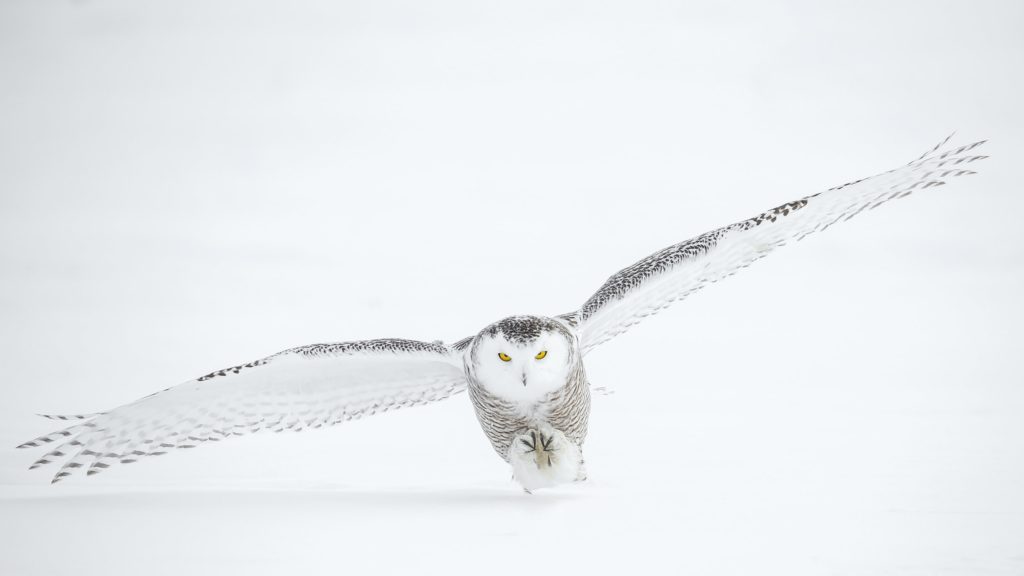Snowy Owls spend most of their lives hunting small rodents in the far Northern reaches of the planet. During the summers, they inhabit the Arctic Circle, hunting for rodents in the unforgiving permafrost of the Arctic tundra. Snowy Owls have a tendency to migrate and wander, so they are sometimes seen outside of their typical ranges.
What is a Snowy Owl “Irruption”
In the winter months these birds can be spotted throughout Canada and in some pockets of the far Northeastern United States. Rarely, large numbers of Snowy Owls make their way into the lower states. These events are known as “irruptions.” Although many believe that the owls that venture South must be experiencing extreme hunger or scarcity of resources, Project SNOWstorm, a collaborative research and conservation group dedicated to Snowy Owls, indicates that the opposite may be true.
Snowy Owl irruptions seem to occur every four to five years and usually coincide with booms in the populations of the rodents and smaller birds on which these raptors feed. When voles and lemmings experience successful reproductive years, Snowy Owls have an abundance of food available and follow suit by breeding in larger numbers.
The winter of 2013/2014 was a historic year for Snowy Owl irruptions. Often referred to as a “mega irruption,” in the winter of 2013/2014 Snowy Owls were spotted as far South as Northern Florida. Since then, more typical irruptions and sightings have occurred, with another noteworthy irruption in the winter of 2017/2018.
Related Article: Snowy Owl Symbolism & Meaning
Snowy Owls in the Winter of 2021/2022
Will We Get A Major Irruption of Snowy Owls in the Winter of 2021/2022?
Unfortunately for birders in the regions of the United States that lie much further South than the Great Lakes, 2021/2022 is not an irruptive year. This means that the typical pattern of rodent population booms followed by an abundance of new Snowy Owls that move outside of their usual range is not occurring or projected to occur.
Fortunately, though, in keeping with their tendency to wander outside of their regular ranges, Snowy Owls are still often spotted South of the Canadian border during non-irruptive years.

Where Can Snowy Owls Be Seen in the Winter of 2021/2022
So far, a Snowy Owl has been spotted in Washington, DC’s Union Station as of January 2022. Though it is not unheard of for Snowy Owls to be spotted in DC during non-irruptive years, DC is well south of their regular range.
Beginning in November of 2021, Snowy Owls have been sighted in the area of Cleveland, Ohio. Cleveland is, however, close enough to the Northern border with Canada that these sightings are fairly common events during the winter season.
When Will the Next Major Irruption of Snowy Owls Happen?
As stated above, Snowy Owl irruptions tend to occur every four to five years. With the last significant irruptive year occurring in the winter of 2017/2018, we may be due for another great season of Snowy Owl spotting in the winter of 2022/2023. Since early 2018 there have been smaller groups of Snowy Owls spotted South of their range, but this was the last serious irruptive year.
To truly determine when another irruption is likely to occur, however, we must keep in mind the factors that contribute to these irruptions. In short, our next irruptive year will likely happen the next time that Snowy Owls have a particularly successful breeding year. To predict this, follow Project SNOWstorm as they research Snowy Owls, their migration patterns, and their conservation concerns.
Popular Article: 12 Best Bushnell Binoculars Worth the Money (2022)


Love reading your articles and learning so much about the different species of birds.
Have always found watching birds in flight so relaxing! Ahhh….soaring overhead … almost like floating in the sky!
Thank you! I’m glad that you’re enjoying my work!
— Hailey Brophy
Writer @ World Birds